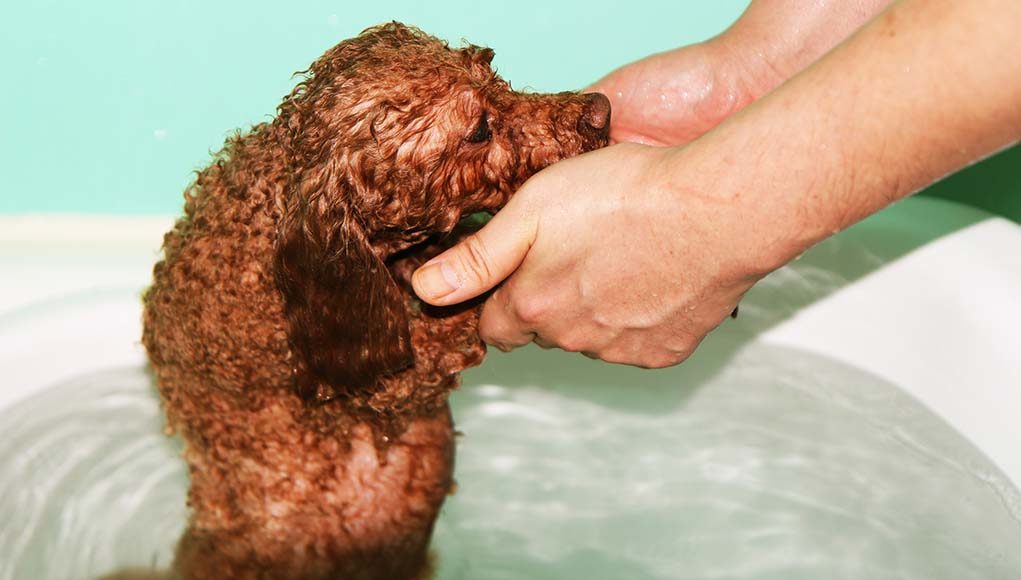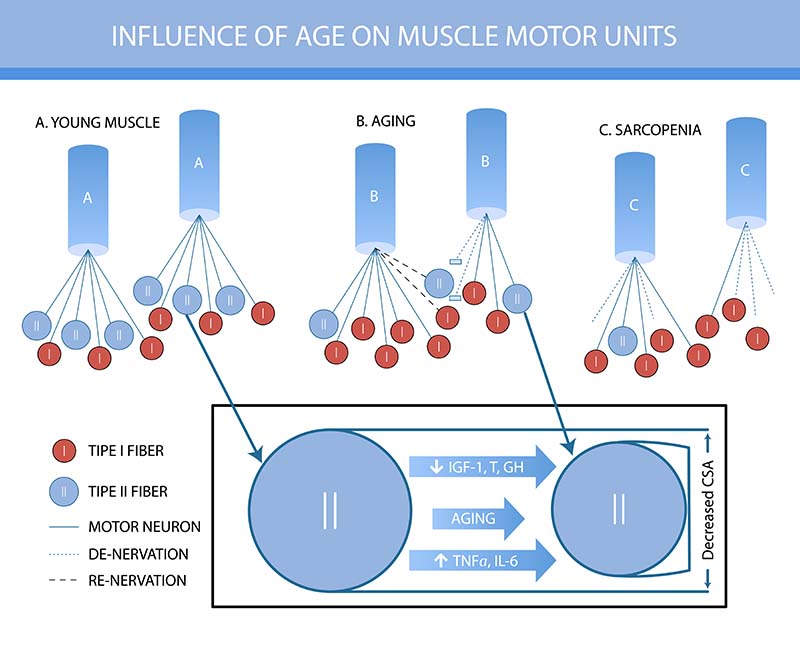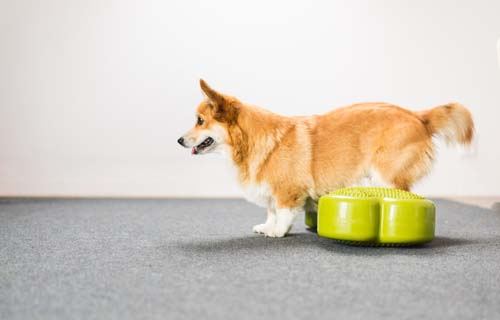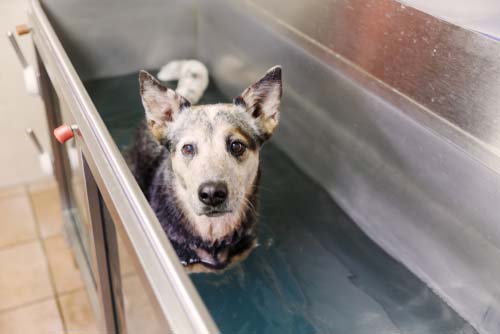Muscle atrophy is a medical condition when the mass of muscles deteriorates, resulting in muscle tissue loss, sometimes in localized areas and other times affecting multiple. Signs of muscle atrophy in dogs include depression, lethargy, paw dragging, weakness, lameness, and noticeably thinning muscles.
Table of Contents
Canine muscle atrophy is commonly seen in senior dogs or those who suffered injury and were on crate-rest for an extended amount of time with little to no activity. There are also several other causes for the this condition, and below is everything pet owners must know about muscle atrophy in dogs. Pinpointing the exact cause of dog muscle atrophy will help you prevent or more effectively treat this condition quickly with better results.
Causes of Muscle Atrophy in Dogs
1. Natural Aging
Common signs of aging in dogs will include graying of their coat, particularly around the dog's eyes and snout, cloudy vision, weight gain, a coarser coat, and weakening muscles among other signs. Along with this, your senior dog will begin losing muscle tissue.
This condition is called Sarcopenia where muscle mass and muscle tone of the dog will inevitably wain. In such cases, canine muscle atrophy isn’t so much a worrisome health condition as it is a part of the natural process of the dog aging.
While muscle loss in senior dogs isn't necessarily a problem because it's natural, there are several other leading causes of muscle wasting and muscle atrophy in dogs of senior age which could prove more problematic, especially if the pet is experiencing them in earlier years.
2. Weight Gain
While weight gain is more probable in old age, today more veterinarians are seeing young dogs suffering from the nutritional disease known as pet obesity. Interestingly, obesity in dogs can cause them to start losing muscle tissue.
The heavier the dog, the more likely they are to develop a multitude of illnesses and conditions, including muscle atrophy. Excessive weight can put a damper on your dog’s general mental and physical health as well as strain their joints, which over the years, could lead to more severe issues, such as arthritis.
3. Arthritis
Arthritis may become an issue for any dog but is most common in large breeds who tend to bear more weight on their joints, slowly deteriorating them over time. While muscle atrophy affects the dog's muscles and arthritis affects the joints, they can be related because the painful strain caused by weakening joints ultimately leads to a lack of full range of movement for the dog.
Canine arthritis is known to displace the work of dog's muscles, thus causing some muscles to overcompensate while others are utilized less, if at all. This takes the form of limping and can slowly lead to eventual muscle atrophy in dogs.
4. Decreased Activity
Many conditions may cause the dog to exercise and move around less. And in a dog that is lacking in daily exercise, muscles will begin to fade as they’re not being purposefully or routinely utilized. A dog may show a disinterest in playtime or walks for a variety of reasons, both mental and physical.
Studies show that the animal might be depressed if they’re left alone at home or in a confined space for a majority of the day; they could be responding to stress as a result of a recent re-homing, loss of family member, or the introduction of a new pet to the home.
Additionally, physical ailments will cause the dog to refrain from being active. Typically, this will be an injury of some kind which makes movement uncomfortable, which will eventually result in progressive muscle atrophy in the dog.
5. Hip Dysplasia
Another common ailment of senior dogs and large or overweight dogs is hip dysplasia which can also cause muscle loss. The hip joint is made up of the femur and pelvis, and together they create a fluid, “ball in socket” motion, allowing dogs to run and play without any issues. However, with hip dysplasia, this fluid motion is replaced with a grinding which eventually erodes the hip joint.
There are different levels of severity for muscle atrophy in dogs related to hip dysplasia condition. With some, there may be a shallow hip socket, a semi-displaced femoral head, or a complete dislocation. Oftentimes, this condition is inherited or may be part of the genetic make-up of the dog.
6. Hypothyroidism
Hypothyroidism equates to an underactive thyroid. Dogs can also be affected by an overactive thyroid which is coined as hyperthyroidism in dogs; however, this is not common and in the veterinary field is typically linked to cancer in dogs.
The thyroid is a small, yet important gland as it controls the metabolism in a dog's body. During hypothyroidism, the immune system mistakes the dog's thyroid gland for an invader, and treating it as a foreign, unwelcome guest, chooses to attack it.
Among signs that show a weakening immune system (such as dog's severe shedding and vulnerability to illnesses and infections), dogs with hypothyroidism will also gain weight, experience a lowered heart rate, and thus have a waning interest in activity. The decrease in exercise and weight gain are big contributors to muscle weakening, deterioration and muscle atrophy in dogs.
How to Prevent Muscle Loss in Dogs
There’s not always a lot to be done to prevent medical conditions in dogs from occurring. However, with an active routine and nutritional diet, a dog’s chances of developing muscle atrophy can be greatly decreased. This can be done by addressing both, muscle atrophy in dogs directly, and potential causes of it discussed above.
1. Scheduled Exercise
Dogs need daily activity. Not only does it keep them healthy both physically and mentally, but it’s also proven that a well-exercised dog is a better-behaved dog. Boredom and lack of an energy outlet may cause dogs to bark excessively, chew up your favorite pair of shoes, or get into the trash can among other problems.
Regular exercise doesn’t just help keep your dogs entertained and out of trouble, but it also helps with their physical health by keeping them in shape and building their muscles. You can also use some strengthening exercises to improve the current muscle condition.
Exercise doesn’t have to mean high-endurance jogs or 10-mile hikes through rugged terrain and gained elevation; it can be something as simple as a 15 to 20-minute walk per day or a game of fetch in the back yard. Even senior dogs or dogs suffering from arthritis need such routine activity to help them build strength and practice flexibility, which minimizes joint pain and fatigue, and reduces risks of dog muscular atrophy.
2. Routine Check-ups
Since dogs are unable to communicate with us, it’s our job to pay attention to their general health by acknowledging any changes in their behavior, routine, or gait. Even when your dog isn’t experiencing or showing signs of pain or discomfort, research shows how routine visits to the veterinarian will ensure you are one step ahead of any potential health hazards. The minimum recommended amount of vet visits for a healthy dog is every 6 months.
3. Better Diet
A good and well-balanced diet adjusted specifically for your dog and their condition(s) is an easy fix. There are a few ways you can monitor your pet’s health by their diet: buy safe, health-promoting dog food and top rated brands, cook homemade dog food meals for your pet yourself, or use a combination of both.
Protein (and amino acids) is the most essential macronutrient in building muscle for dogs, so every dog needs to receive adequate amount. Remember to balance the amount of protein with consideration to other health issues of a dog, especially senior pets with renal or liver disease.
Another key to a balanced diet to prevent muscle loss in dogs is to not overfeed your pet. Always discuss any major dietary changes with a veterinarian before making them. Even trying a new brand of kibble can upset a dog’s stomach or provide less essential nutrition a dog needs, especially if a dog's body has grown used to a specific diet.
4. Supplements
Certain conditions in dogs require dietary adjustments, and sometimes, you're unable to address all nutritional requirements of an ill dog without adding more calories and overfeeding your pet. In such cases, pet supplements could be helpful.
For muscle loss in dogs, a MYOS formula supplement have been found helpful in maintaining and building muscle tissue. Another potentially helpful supplement is Taurine, which is one of the muscle building blocks in the body that comes from protein. Finally, some of the joint health supplements like Extended Pet may assist with issues related to dog muscle loss. Always consult with your veterinarian before using any of these.
4. Variety in the Diet
To prevent muscle atrophy in dogs, a well-balanced diet looks a lot like what you may eat when you’re on a health kick. While dogs do not require variety in their diet to entertain their taste buds, there are certain cases where pet owners might need to change things up once in a while. Allergies and health problems is one of the main reasons to do so.
Pure proteins, such as beef, chicken, and fish are great for building muscles in dogs, as long as it's not too much. Healthy oils and fats such as coconut oil and fish oil are a great addition to a dog’s diet as well, with the added bonus that it helps promote hydrated skin and a healthy coat. Dark, leafy greens is another wonderful resource as dog's body crave vitamins as much as they crave protein and fat from meat.
While most carbohydrate sources should be avoided, there are certain vegetables and fruits that have been scientifically proven to improve dog's health, and may help with dog muscle atrophy. Sweet potatoes and pumpkin puree are two examples of safe, nutritional carbs and fiber that will add more variety to the diet.
6. Essential Vitamins and Nutrients
Other than supplements that are designed to directly help with dog muscle loss, some other multivitamins can be effective for dogs with or at risk of muscle atrophy. Those are omega-3 fatty acids (proven to help with muscle loss in humans) and a range of anti-oxidants. While EPA/DHA essential fatty acids are saturated in fish, they also come in dog-friendly pills or fish oil bottles.
Vitamins can be given to dogs in pill form, but just as is the case with humans, it's best to feed them through food, either your dog's kibble or natural veggies and fruits. Many berries, such as blueberries and raspberries, are full of antioxidants, are safe and delicious for dogs, and have been scientifically proven to improve canine health.
7. Smarter Shopping
If it’s not within your budget to feed your pet two meals of whole chicken breast, sautéed spinach, and pureed sweet potatoes every day using homemade dog food recipes, then supplement your dog's diet by doing one prepped meal and one kibble meal a day.
A recent study found that 1 in 3 of American dogs are overweight, and although the statistic is bleak, it’s good news for you because it means there are plenty of options for weight control dog foods on the market. There's a number of weight loss dog food brands available, but you can also pick regular brands and check the ingredients list and count calories for your dog.
Remember that dog food brands that claim “healthy”, “organic” or “weight management” can have additives not recommended to a pet with weight, joint or muscle atrophy in dogs issues. Common sense will tell you to avoid high caloric foods and wheat gluten, corn gluten, color dyes, and chemical preservatives (BHA, BHT). These synthetic ingredients have been linked to causing weight gain and/or kidney issues.
8. Use a Slow Feeding Bowl
Slow feeder bowls are an excellent tool, not just to owners of overweight dogs, but to anyone making an effort to ensure their dog is healthy. They can also assist in dealing with muscular atrophy in dogs.
A slow feeding bowl is generally inexpensive and can be found online or at a local pet supply store. They come in a variety of sizes, making them perfect for any dog from a Chihuahua to a Great Dane, and monitor a dog’s eating habits and meal size. There are also several game or play related feeders, many of which are designed by KONG brand.
A number of KONG devices can be stuffed with any tasty treats (peanut butter, shredded chicken, kibble or treats) forcing your pets to work for their food. This is not only mentally challenging and fun for the dog, but it also can ensure the dogs aren’t overeating or eating too quickly.
9. Supportive Bedding
This is often overlooked by pet owners dealing with muscle atrophy in dogs, but how and where your dog lays can have a long-term effect on their joints, muscle and related health conditions.
Orthopedic dog beds will keep your pet comfortable but also lower their overall risk of developing a health condition that could cause muscle atrophy. These beds require less pressure and stress on their joints and muscles than lying on a hard surface like the ground or kennel floor.
Treatments of Dog Muscle Atrophy
Because muscle atrophy in dogs is the result of several different health conditions, treatments will often vary. Several treatment plans may include a combination of any of the following and all will do nothing but benefit your dog’s muscle and joint health.
1. Aquatic Therapy (Hydrotherapy)
The benefits of hydrotherapy and underwater treadmills are ideal for breeds that love water, such as Labradors, who were specifically bred to have webbed feet, making them natural and excellent doggie-paddlers. Aquatic therapy, or hydrotherapy, has scientifically proven benefits for dogs, including prevention and treatment of muscle tissue loss.
This is something you can set up with an animal chiropractor but with some basic knowledge of safe practices and helpful exercises, it’s also an activity you and your dog can explore together, without the guidance of a professional. According to veterinarians, this is one of the most effective ways to deal with pain and muscle atrophy in dogs.
A regular swimming pool, dog pool, ocean or lake are wonderful resources to overweight and senior dogs as well as dogs who are in recovery from a surgery because they offer a weightless environment for the pup to move, have fun, and best of all, keep their muscles and joins in motion with little pain.
2. Adequan Injections
A veterinary-prescribed treatment for animals suffering from arthritis, Adequan for dogs is an FDA-approved inject-able serum that improves joint health, acts as pain relief, as well as combats arthritis by attacking cartilage-wearing enzymes.
It's commonly recommended by veterinarians as a series of injections that typically take place over the course of 6 to 8 weeks with the dog experiencing mild side effects, such as diarrhea and irritation at the injection site.
3. Massage
There are numerous benefits to massaging your dog, especially when experiencing muscle atrophy in dogs and/or general pain. When a dog's muscles are targeted and given the right amount of pressure while massaged, tendons and ligaments relax, and blood flow is increased. As part of physical therapy, dog massage has been proven to relieve pain and help with dog's recovery.
There's a number of methods to massage your pet, but always check with a veterinarian before trying to be your dog's personal masseuse. Some health conditions like muscle atrophy in dogs, or particularly those associated with joints or muscles, require gentle or no pressure to the area in question. It might be better to use a professional.
4. Supplements
Similar to using supplements to prevent muscle atrophy in dogs, you can use similar and other ones for treatment. Your veterinarian may also suggest natural anti-inflammatories, such as turmeric-based pills as well as pain relievers to aid in muscle atrophy treatment.
These are meant to help with any pain your pet may be experiencing due to the muscle loss and to inspire them to be more active which in turn helps combat their weakening muscles. Other supplements may include those often given for arthritis which aid in cartilage repair and strength such as Glucosamine (with Chondroitin) or even muscle building additives such as whey protein for dogs.
Recently, there's been more research done on muscle atrophy in dogs, and new supplements are coming into light. Most recent news was the supplement called MYOS Canine Muscle Formula, announced in February 2019, that has been shown to effectively treat muscle atrophy in dogs specifically. This is the first of it's kind developed by MYOS, a company specifically focused on science of muscle retention in dogs.
MYOS Canine Muscle Formula for muscle atrophy in dogs:
- BUILD MUSCLE MASS: MYOS Canine...
- ONE ALL-NATURAL INGREDIENT:...
- IMPROVED MOBILITY: Ideal for...
- SENIOR SUPPORT: Muscle loss is...
- OUR PROMISE TO YOU: All MYOS...
5. Passive Range-of-Motion Exercises
Other than pet message, a veterinarian may recommend physical therapy intended to help both joints and muscles and send you home with a few exercises to do with your pet. This is likely to be one of the more effective ways to treat muscle atrophy in dogs and any related conditions such as arthritis and post-surgery recovery.
Passive range of motion movements are best performed while your dog is in a relaxed state and position – on their side, laying down. These exercises will involve you bracing an upper joint while gently and slowly moving a lower one.
For instance, if your dog's muscle atrophy was occurring in the right leg, you would have your pet lay on their left side and gingerly extend their right leg out and in (like in the picture above), for a few reps, sometimes holding it out in the extended position for several seconds.
When performed two to three times a day, this form of physical therapy has been proven to be very helpful to canine patients suffering from joint and muscle weakening.
6. Gene Therapy
The last on the list of dog muscle atrophy treatments is something completely new in the veterinary field that's soon to be available but isn't yet – gene therapy for dogs. Most recent studies have shown how scientists at UW Medicine Institute for Stem Cell and Regenerative Medicine used single infusion to restore dog's strength and to prolong affected canines' lives. This might be one of the most effective and promising treatments for muscle atrophy in dogs but we'll have to wait a little longer for it.
READ NEXT: Dog Muscle Spasms – What You Need to Know (and Do)
Disclosure: We may earn affiliate commissions at no cost to you from the links on this page. This did not affect our assessment of products. Read more here and find full disclosure here.

















